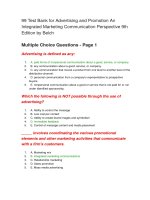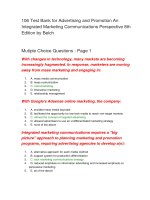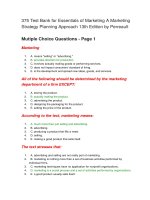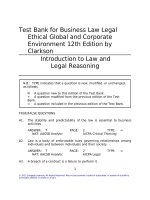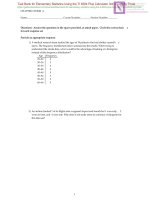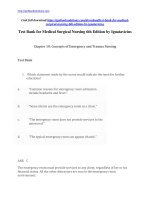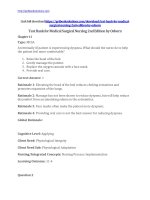Test bank for medical surgical nursing clinical reasoning in patient care 6th edition by lemone download
Bạn đang xem bản rút gọn của tài liệu. Xem và tải ngay bản đầy đủ của tài liệu tại đây (388.83 KB, 58 trang )
Test Bank for Medical Surgical Nursing Clinical Reasoning in
Patient Care 6th Edition by LeMone
Chapter 1: Dimensions of Medical-Surgical Nursing
Question 1
Type: MCSA
The nurse is instructing a patient on the role of diet, exercise, and medication to control type 2
diabetes mellitus. Which core competency for healthcare professionals is the nurse implementing?
1. Quality improvement
2. Evidence-based practice
3. Patient-centered care
4. Teamwork and collaboration
Correct Answer: 3
Rationale 1: Identifying safety hazards and measuring quality is an example of the core competency
quality improvement.
Rationale 2: Using best research when providing patient care is an example of the core
competency evidence-based practice.
Rationale 3: The nurse instructing the patient is an example of the competency patient-centered care.
Rationale 4: The core competency teamwork and collaboration involves collaboration between
disciplines to provide continuous and reliable care.
Global Rationale: In 2003, the National Academy of Sciences proposed a set of five core competencies
that all healthcare professionals should possess to meet the needs of the 21st century. The nurse
instructing the patient is an example of the competency patient-centered care. Identifying safety hazards
and measuring quality are examples of the core competency quality improvement. Using best research
when providing patient care is an example of the core competency evidence-based practice.
Collaboration between disciplines to provide continuous and reliable care is an example of the core
competency teamwork and collaboration.
LeMone/Burke/Bauldoff/Gubrud, Medical-Surgical Nursing 6th Edition Test
Bank Copyright 2015 by Pearson Education, Inc.
Cognitive Level: Applying
Client Need: Safe and Effective Care Environment
Client Need Sub: Management of Care
QSEN Competencies: I.A.1. Integrate understanding of multiple dimensions of patient centered care
AACN Essential Competencies: IX.7. Provide appropriate patient teaching that reflects
developmental stage, age, culture, spirituality, patient preferences, and health literacy considerations to
foster patient engagement in their care
NLN Competencies: Relationship Centered Care: Learn cooperatively, facilitate the learning of others
Nursing/Integrated Concepts: Nursing Process: Implementation
Learning Outcome: 1. Describe the core competencies for healthcare professionals: patientcentered care, interprofessional teams, evidence-based practice, quality improvement, safety, and
health information technology.
MNL Learning Outcome: 10.5.4. Utilize the nursing process in care of client.
Page Number: 4
Question 2
Type: MCSA
The nurse is planning to utilize the core competency use informatics when providing patient care.
Which action should the nurse perform when using this core competency?
1. Change the sharps container in a patient’s room.
2. Document the effectiveness of pain medication for a patient.
3. Discuss the effectiveness of bedside physical therapy with the therapist.
4. Search through a database of articles to find current research on wound care.
Correct Answer: 4
Rationale 1: Changing the sharps container is an example of quality improvement.
Rationale 2: Documenting the effectiveness of pain medication for a patient is an example of
patient-centered care.
Rationale 3: Discussing the effectiveness of bedside physical therapy with the therapist is an example
of teamwork and collaboration.
LeMone/Burke/Bauldoff/Gubrud, Medical-Surgical Nursing 6th Edition Test
Bank Copyright 2015 by Pearson Education, Inc.
Rationale 4: Searching through a database of articles to find current research on wound care is an
example of use informatics.
Global Rationale: Examples of the nurse using the core competency use informatics include the use of
technology to communicate, manage knowledge, reduce errors, and support decision making. The
activity of searching through a database of articles to find current research on wound care is an
example of use informatics. Changing the sharps container in a patient’s room is an example of quality
improvement. Documenting the effectiveness of pain medication for a patient is an example of patientcentered care. Discussing the effectiveness of bedside physical therapy with the therapist is an example
of teamwork and collaboration.
Cognitive Level: Applying
Client Need: Safe and Effective Care Environment
Client Need Sub: Management of Care
QSEN Competencies: VI.B.2. Apply technology and information management tools to support
safe processes of care
AACN Essentials Competencies: IV.1. Demonstrate skills in using patient care technologies,
information systems, and communication devices that support safe nursing practice
NLN Competencies: Knowledge and Science: Electronic databases; literature retrieval; evaluating data
for validity and reliability; evidence and best practices for nursing
Nursing/Integrated Concepts: Nursing Process: Planning
Learning Outcome: 1. Describe the core competencies for healthcare professionals: patientcentered care, interprofessional teams, evidence-based practice, quality improvement, safety, and
health information technology.
MNL Learning Outcome: 4.3.3. Examine the treatments used for pressure ulcers.
Page Number: 4
Question 3
Type: MCMA
The nurse plans to implement evidence-based practice when providing patient care. Which activities
should the nurse perform?
Standard Text: Select all that apply.
1. Participate in education and research activities when possible.
2. Integrate research findings with clinical care to maximize patient outcomes.
3. Serve on the committee to create critical pathways for patient care.
LeMone/Burke/Bauldoff/Gubrud, Medical-Surgical Nursing 6th Edition Test
Bank Copyright 2015 by Pearson Education, Inc.
4. Reinforce hand hygiene techniques with unlicensed assistive personnel.
5. Contact Environmental Services to report a malfunctioning infusion pump.
Correct Answer: 1, 2
Rationale 1: Participating in education and research activities when possible is an example of
implementing evidence-based practice in the provision of patient care.
Rationale 2: Integrating research findings with clinical care to maximize patient outcomes is an example
of implementing evidence-based practice in the provision of patient care.
Rationale 3: Serving on the committee to create critical pathways for patient care is an example
of teamwork and collaboration.
Rationale 4: Reinforcing hand hygiene techniques with unlicensed assistive personnel is an example
of quality improvement.
Rationale 5: Contacting Environmental Services to report a malfunctioning infusion pump is an example
of quality improvement.
Global Rationale: Participating in education and research activities when possible is an example of
implementing evidence-based practice in the provision of patient care. Integrating research findings with
clinical care to maximize patient outcomes is an example of implementing evidence-based practice in the
provision of patient care. Serving on the committee to create critical pathways for patient care is an
example of teamwork and collaboration. Reinforcing hand hygiene techniques with unlicensed assistive
personnel is an example of quality improvement. Contacting Environmental Services to report a
malfunctioning infusion pump is an example of quality improvement.
Cognitive Level: Applying
Client Need: Safe and Effective Care Environment
Client Need Sub: Management of Care
QSEN Competencies: III.B.6. Participate in structuring the work environment to facilitate integration of
new evidence into standards of practice
AACN Essentials Competencies: III.2. Demonstrate an understanding of the basic elements of the
research process and models for applying evidence to clinical practice
NLN Competencies: Knowledge and Science; Defining what is evidence-based practice
Nursing/Integrated Concepts: Nursing Process: Planning
LeMone/Burke/Bauldoff/Gubrud, Medical-Surgical Nursing 6th Edition Test
Bank Copyright 2015 by Pearson Education, Inc.
Learning Outcome: 1. Describe the core competencies for healthcare professionals: patientcentered care, interprofessional teams, evidence-based practice, quality improvement, safety, and
health information technology.
MNL Learning Outcome:
Page Number: 4
Question 4
Type: MCSA
The community health nurse is planning to meet with several community members during a health
fair. Which nursing activity exemplifies the core competency patient-centered care?
1. Provide smoking cessation classes and literature.
2. Increase the hours for the physician to see patients.
3. Attend a continuing education program on clean water initiatives.
4. Evaluate the effectiveness of weight reduction strategies.
Correct Answer: 1
Rationale 1: Providing smoking cessation classes and literature is an example of an activity to provide
patient-centered care.
Rationale 2: Increasing the hours for the physician to see patients is an activity to support
the competency teamwork and collaboration.
Rationale 3: Attending a continuing education program on clean water initiatives is an activity to support
the competency evidence-based practice.
Rationale 4: Evaluating the effectiveness of weight reduction strategies is an activity to support
the competency quality improvement.
Global Rationale: Activities to exemplify the core competency patient-centered care should be focused
on disease prevention, wellness, and promotion of healthy lifestyles. Providing smoking cessation
classes and literature is an example of patient-centered care. Increasing the hours for the physician to see
patients is an activity to support the competency teamwork and collaboration. Attending a continuing
education program on clean water initiatives is an activity to support the competency evidence-based
LeMone/Burke/Bauldoff/Gubrud, Medical-Surgical Nursing 6th Edition Test
Bank Copyright 2015 by Pearson Education, Inc.
practice. Evaluating the effectiveness of weight reduction strategies is an activity to support
the competency quality improvement.
Cognitive Level: Applying
Client Need: Safe and Effective Care Environment
Client Need Sub: Management of Care
QSEN Competencies: I.B.3. Provide patient-centered care with sensitivity and respect for the diversity
of human experience
AACN Essentials Competencies: IX.3. Implement holistic, patient-centered care that reflects an
understanding of human growth and development, pathophysiology, pharmacology, medical
management and nursing management across the health-illness continuum, across lifespan, and in all
healthcare settings
NLN Competencies: Context and Environment; Knowledge; health promotion/disease prevention
Nursing/Integrated Concepts: Nursing Process: Planning
Learning Outcome: 1. Describe the core competencies for healthcare professionals: patientcentered care, interprofessional teams, evidence-based practice, quality improvement, safety, and
health information technology.
MNL Learning Outcome: 5.9.4. Utilize the nursing process in care of client.
Page Number: 4
Question 5
Type: MCSA
The nurse is instructing a patient on weight reduction and smoking cessation. Which code of
nursing practice is the nurse implementing?
1. International Council of Nurses Code of Ethics for Nurses
2. American Nurses Association Standards of Professional Practice
3. American Nurses Association Code of Ethics for Nurses
4. State Board of Nursing Code
Correct Answer: 1
Rationale 1: The International Council of Nurses (ICN) Code of Ethics for Nurses specifies what nurses
are accountable for in terms of people, practice, society, coworkers, and the profession. The
philosophical basis for this code is that nurses are responsible for promoting health, preventing illness,
LeMone/Burke/Bauldoff/Gubrud, Medical-Surgical Nursing 6th Edition Test
Bank Copyright 2015 by Pearson Education, Inc.
and alleviating suffering. Instructing a patient on weight reduction and smoking cessation exemplifies
the ICN Code of Ethics for Nurses.
Rationale 2: The American Nurses Association Standards of Professional Practice are standards, not
a code, and focus on specific behaviors to address quality practice, practice evaluation, education,
collegiality, collaboration, ethics, research, resource utilization, and leadership.
Rationale 3: The American Nurses Association Code of Ethics for Nurses has nine statements that
address the nurse’s professional relationships, commitment to patients, patient rights, nursing practice,
competency, conditions of employment, and contributions to the science of nursing, collaboration,
and nursing values.
Rationale 4: The state boards of nursing do not publish codes for nursing.
Global Rationale: The International Council of Nurses (ICN) Code of Ethics for Nurses specifies what
nurses are accountable for in terms of people, practice, society, coworkers, and the profession. The
philosophical basis for this code is that nurses are responsible for promoting health, preventing illness,
and alleviating suffering. Instructing a patient on weight reduction and smoking cessation exemplifies the
ICN Code of Ethics for Nurses. The American Nurses Association Standards of Professional Practice are
standards, not a code, and focus on specific behaviors to address quality practice, practice evaluation,
education, collegiality, collaboration, ethics, research, resource utilization, and leadership. The American
Nurses Association Code of Ethics for Nurses has nine statements that address the nurse’s professional
relationships, commitment to patients, patient rights, nursing practice, competency, conditions of
employment, and contributions to the science of nursing, collaboration, and nursing values. The state
boards of nursing do not publish codes for nursing.
Cognitive Level: Applying
Client Need: Safe and Effective Care Environment
Client Need Sub: Management of Care
QSEN Competencies: I.A.1. Integrate understanding of multiple dimensions of patient centered care
AACN Essentials Competencies: VII.4. Use behavioral change techniques to promote health
and manage illness
NLN Competencies: Context and Environment; Knowledge; health promotion/disease prevention
Nursing/Integrated Concepts: Nursing Process: Implementation
Learning Outcome: 4. Explain the importance of nursing and interprofessional codes of ethics
and standards of practice as guidelines for clinical nursing practice.
MNL Learning Outcome: 5.9.4. Utilize the nursing process in care of client.
Page Number: 9
LeMone/Burke/Bauldoff/Gubrud, Medical-Surgical Nursing 6th Edition Test
Bank Copyright 2015 by Pearson Education, Inc.
Question 6
Type: MCSA
The nurse is providing patient care within the American Nurses Association Standards of
Professional Performance. Which activity is the nurse implementing?
1. Integrating research findings into practice
2. Implementing a patient’s plan of care
3. Evaluating patient progress toward identified outcomes
4. Analyzing assessment data to determine issues
Correct Answer: 1
Rationale 1: The nurse who is practicing within the American Nurses Association Standards of
Professional Performance would integrate research findings into practice. The standards focus on ethics,
education, evidence-based practice and research, quality nursing practice, communication, leadership,
collaboration, professional practice evaluation, resource utilization, and environmental health.
Rationale 2: Implementing a patient’s plan of care is an example of adhering to the American
Nurses Association Standards of Practice.
Rationale 3: Evaluating patient progress toward identified outcomes is an example of adhering to the
American Nurses Association Standards of Practice.
Rationale 4: Analyzing assessment data to determine issues is an example of adhering to the
American Nurses Association Standards of Practice.
Global Rationale: The nurse who is practicing within the American Nurses Association Standards of
Professional Performance would integrate research findings into practice. The standards focus ethics,
education, evidence-based practice and research, quality nursing practice, communication, leadership,
collaboration, professional practice evaluation, resource utilization, and environmental health. The
other activities would be implemented when the nurse is adhering to the American Nurses Association
Standards of Practice.
Cognitive Level: Applying
Client Need: Safe and Effective Care Environment
Client Need Sub: Management of Care
LeMone/Burke/Bauldoff/Gubrud, Medical-Surgical Nursing 6th Edition Test
Bank Copyright 2015 by Pearson Education, Inc.
QSEN Competencies: III.B.6. Participate in structuring the work environment to facilitate integration of
new evidence into standards of practice
AACN Essentials Competencies: III.2. Demonstrate an understanding of the basic elements of the
research process and models for applying evidence to clinical practice
NLN Competencies: Knowledge and Science; Defining what is evidence-based practice
Nursing/Integrated Concepts: Nursing Process: Implementation
Learning Outcome: 4. Explain the importance of nursing and interprofessional codes of ethics
and standards of practice as guidelines for clinical nursing practice.
MNL Learning Outcome:
Page Number: 10
Question 7
Type: MCSA
The nurse prescribes strategies and alternatives to assist a patient achieve expected outcomes. Within
which American Nurses Association standard is the nurse practicing?
1. Planning
2. Assessment
3. Diagnosis
4. Implementation
Correct Answer: 1
Rationale 1: The American Nurses Association Standards of Practice follow the nursing process. The
nurse who prescribes strategies and alternatives to assist a patient achieve expected outcomes is
practicing within the standard of planning.
Rationale 2: Assessment activities include data collection.
Rationale 3: Diagnosis activities include analyzing data to determine issues.
Rationale 4: Implementation activities include implementing the identified plan, coordinating care
delivery, and employing strategies to promote health and a safe environment.
Global Rationale: The American Nurses Association Standards of Practice follow the nursing process.
The nurse who prescribes strategies and alternatives to assist a patient achieve expected outcomes is
LeMone/Burke/Bauldoff/Gubrud, Medical-Surgical Nursing 6th Edition Test
Bank Copyright 2015 by Pearson Education, Inc.
practicing within the standard of planning. Assessment activities include data collection.
Diagnosis activities include analyzing data to determine issues. Implementation activities
include implementing the identified plan, coordinating care delivery, and employing strategies
to promote health and a safe environment.
Cognitive Level: Applying
Client Need: Safe and Effective Care Environment
Client Need Sub: Management of Care
QSEN Competencies: I.B.3. Provide patient-centered care with sensitivity and respect for the diversity
of human experience
AACN Essentials Competencies: IX.3. Implement holistic, patient-centered care that reflects an
understanding of human growth and development, pathophysiology, pharmacology, medical
management and nursing management across the health-illness continuum, across lifespan, and in all
healthcare settings
NLN Competencies: Context and Environment; Practice; conduct population-based transcultural health
assessments and interventions
Nursing/Integrated Concepts: Nursing Process: Implementation
Learning Outcome: 4. Explain the importance of nursing and interprofessional codes of ethics
and standards of practice as guidelines for clinical nursing practice.
MNL Learning Outcome:
Page Number: 10
Question 8
Type: MCSA
A patient with a terminal illness is concerned about pain control. If the International Council of Nurses
Code of Ethics for Nurses is followed, what should the nurse plan for the patient?
1. Measures to alleviate suffering
2. Modified activities of daily living
3. Enforcement of strict bed rest
4. Dietary interventions to maximize strength
Correct Answer: 1
LeMone/Burke/Bauldoff/Gubrud, Medical-Surgical Nursing 6th Edition Test
Bank Copyright 2015 by Pearson Education, Inc.
Rationale 1: The philosophical basis for the International Council of Nurses Code of Ethics for Nurses
is the responsibility to promote health, prevent illness, and alleviate suffering. The nurse should plan
measures to alleviate the patient’s suffering.
Rationale 2: Modified activities of daily living may not affect pain control.
Rationale 3: Enforcement of strict bed rest may not affect pain control.
Rationale 4: Dietary interventions to maximize strength may not affect pain control.
Global Rationale: The philosophical basis for the International Council of Nurses Code of Ethics for
Nurses is the responsibility to promote health, prevent illness, and alleviate suffering. The nurse should
plan measures to alleviate the patient’s suffering. Modified activities of daily living, enforcement of strict
bed rest, and dietary interventions to maximize strength may not affect pain control.
Cognitive Level: Applying
Client Need: Safe and Effective Care Environment
Client Need Sub: Management of Care
QSEN Competencies: I.B.7. Initiate effective treatments to relieve pain and suffering in light of patient
values, preferences and expressed needs
AACN Essentials Competencies: IX.6. Implement patient and family care around resolution of end-oflife and palliative care issues, such as symptom management, support of rituals, and respect for patient
and family preferences
NLN Competencies: Knowledge and Science; Practice; Translate research into practice in order to
promote quality and improve practices
Nursing/Integrated Concepts: Nursing Process: Planning
Learning Outcome: 4. Explain the importance of nursing and interprofessional codes of ethics
and standards of practice as guidelines for clinical nursing practice.
MNL Learning Outcome: 3.4.3. Critique interventions appropriate for the client with cancer.
Page Number: 9
Question 9
Type: MCSA
A patient is angry after waiting over an hour for pain medication. What should the nurse respond to
the patient that demonstrates critical thinking?
1. “I understand your anger and am sorry for the delay. I have your pain medication now.”
2. “I had other patients who needed my attention first, so I did a few things before getting the
pain medication.”
LeMone/Burke/Bauldoff/Gubrud, Medical-Surgical Nursing 6th Edition Test
Bank Copyright 2015 by Pearson Education, Inc.
3. “I needed to find out what your medication is and if you can have more when you asked.”
4. “It seems that you always ask for pain medication when I am trying to do other things.”
Correct Answer: 1
Rationale 1: Critical thinking is evident when the nurse challenges assumptions, overtly identifies
and acknowledges the values and beliefs he/she brings to the situation, considers the influence of
context, generates possible explanations, and deliberately maintains healthy skepticism. For the
patient who is angry, this statement demonstrates empathy and critical thinking.
Rationale 2: This statement is not an example of critical thinking and would be an
inappropriate response.
Rationale 3: This statement is not an example of critical thinking and would be an
inappropriate response.
Rationale 4: This statement is not an example of critical thinking and would be an
inappropriate response.
Global Rationale: Critical thinking is evident when the nurse challenges assumptions, overtly identifies
and acknowledges the values and beliefs he/she brings to the situation, considers the influence of
context, generates possible explanations, and deliberately maintains healthy skepticism. As the patient is
angry, the statement that demonstrates empathy and critical thinking is “I understand your anger and am
sorry for the delay. I have your pain medication now.” The other choices are not examples of critical
thinking and would be inappropriate responses.
Cognitive Level: Applying
Client Need: Safe and Effective Care Environment
Client Need Sub: Management of Care
QSEN Competencies: I.B.7. Initiate effective treatments to relieve pain and suffering in light of patient
values, preferences and expressed needs
AACN Essentials Competencies: IX.6. Implement patient and family care around resolution of end-oflife and palliative care issues, such as symptom management, support of rituals, and respect for patient
and family preferences
NLN Competencies: Knowledge and Science; Practice; Translate research into practice in order to
promote quality and improve practices
Nursing/Integrated Concepts: Nursing Process: Implementation
Learning Outcome: 3. Apply the attitudes, mental habits, and skills necessary for clinical
reasoning when using the nursing process in patient care.
LeMone/Burke/Bauldoff/Gubrud, Medical-Surgical Nursing 6th Edition Test
Bank Copyright 2015 by Pearson Education, Inc.
MNL Learning Outcome:
Page Number: 4
Question 10
Type: MCSA
The nurse is reviewing data collected from a patient during an assessment. Which activity demonstrates
that the nurse is using divergent thinking when analyzing this data?
1. The nurse identifies abnormal data for further analyzing.
2. The nurse focuses on normal data to rule out health problems.
3. The nurse discriminates between facts and guesses.
4. The nurse thinks about the information to determine solutions.
Correct Answer: 1
Rationale 1: Divergent thinking, a critical-thinking skill, is the ability to weigh the importance of
information. The nurse should sort out the data that are relevant from data that are irrelevant for the
patient, remembering that abnormal data are usually considered relevant.
Rationale 2: Normal data are helpful but may not change the care to provide to the patient. This is
not divergent thinking because it does not weigh the importance of the information.
Rationale 3: Discriminating between facts and guesses describes the critical-thinking skill of reasoning.
Rationale 4: Thinking about the information to determine solutions describes the critical-thinking skill of
reflection.
Global Rationale: Divergent thinking, a critical-thinking skill, is the ability to weigh the importance
of information. The nurse should sort out the data that are relevant from data that are irrelevant for the
patient. Abnormal data are usually considered relevant; normal data are helpful but may not change the
care to provide to the patient. Discriminating between facts and guesses describes the critical-thinking
skill of reasoning. Thinking about the information to determine solutions describes the critical-thinking
skill of reflection.
Cognitive Level: Applying
Client Need: Safe and Effective Care Environment
LeMone/Burke/Bauldoff/Gubrud, Medical-Surgical Nursing 6th Edition Test
Bank Copyright 2015 by Pearson Education, Inc.
Client Need Sub: Management of Care
QSEN Competencies: III.A.1. Demonstrate knowledge of basic scientific methods and processes
AACN Essentials Competencies: III.6. Integrate evidence, clinical judgment, interprofessional
perspectives and patient preferences in planning, implementing, and evaluating outcomes of care
NLN Competencies: Knowledge and Science; Practice; Translate research into practice in order to
promote quality and improve practices
Nursing/Integrated Concepts: Nursing Process: Implementation
Learning Outcome: 3. Apply the attitudes, mental habits, and skills necessary for clinical
reasoning when using the nursing process in patient care.
MNL Learning Outcome:
Page Number: 4
Question 11
Type: MCSA
The nurse is identifying nursing diagnoses appropriate for a patient’s plan of care. What should the
nurse use to determine these diagnoses?
1. Diagnostic reasoning
2. Communication techniques
3. Identified outcome criteria
4. Established priorities
Correct Answer: 1
Rationale 1: Making a diagnosis is a complex process, and the nurse uses diagnostic reasoning to choose
nursing diagnoses that best define the individual patient’s health problems. Diagnostic reasoning is a
form of clinical judgment used to make decisions about which label, or diagnosis, best describes the
patterns of data. Steps in the process include identifying significant cues, clustering the cues and
identifying gaps, drawing conclusions about the present health status, and determining etiologies and
categorizing problems.
Rationale 2: Communication techniques would be needed when conducting the patient assessment.
Rationale 3: Identification of outcome criteria is a part of the planning phase of the nursing process.
Rationale 4: Priorities are established during the implementation phase of the nursing process.
LeMone/Burke/Bauldoff/Gubrud, Medical-Surgical Nursing 6th Edition Test
Bank Copyright 2015 by Pearson Education, Inc.
Global Rationale: Making a diagnosis is a complex process, and the nurse uses diagnostic reasoning to
choose nursing diagnoses that best define the individual patient’s health problems. Diagnostic reasoning
is a form of clinical judgment used to make decisions about which label, or diagnosis, best describes the
patterns of data. Steps in the process include identifying significant cues, clustering the cues and
identifying gaps, drawing conclusions about the present health status, and determining etiologies and
categorizing problems. Communication techniques would be needed when conducting the patient
assessment. Identification of outcome criteria is a part of the planning phase of the nursing process.
Priorities are established during the implementation phase of the nursing process.
Cognitive Level: Applying
Client Need: Safe and Effective Care Environment
Client Need Sub: Management of Care
QSEN Competencies: I.A.1. Integrate understanding of multiple dimensions of patient centered care
AACN Essentials Competencies: III.6. Integrate evidence, clinical judgment, interprofessional
perspectives and patient preferences in planning, implementing, and evaluating outcomes of care
NLN Competencies: Knowledge and Science; Practice; Translate research into practice in order to
promote quality and improve practices
Nursing/Integrated Concepts: Nursing Process: Diagnosis
Learning Outcome: 3. Apply the attitudes, mental habits, and skills necessary for clinical
reasoning when using the nursing process in patient care.
MNL Learning Outcome:
Page Number: 6
Question 12
Type: MCSA
The nurse plans and implements care for a patient based on nursing knowledge and skills. In which
role is the nurse functioning?
1. Caregiver
2. Advocate
3. Educator
4. Leader
Correct Answer: 1
LeMone/Burke/Bauldoff/Gubrud, Medical-Surgical Nursing 6th Edition Test
Bank Copyright 2015 by Pearson Education, Inc.
Rationale 1: The caregiver role for the nurse today is both independent and collaborative. Nurses
independently make assessments and plan and implement patient care based on nursing knowledge
and skills.
Rationale 2: The nurse functioning as a patient advocate actively promotes the patient’s rights
to autonomy and free choice.
Rationale 3: The nurse functioning in the role of educator nurse assesses learning needs, plans and
implements teaching methods to meet those needs, and evaluates the effectiveness of the teaching.
Rationale 4: The nurse functioning in the role of leader directs, delegates, and coordinates
nursing activities.
Global Rationale: The caregiver role for the nurse today is both independent and collaborative. Nurses
independently make assessments and plan and implement patient care based on nursing knowledge and
skills. The nurse functioning as a patient advocate actively promotes the patient’s rights to autonomy
and free choice. The nurse functioning in the role of educator nurse assesses learning needs, plans and
implements teaching methods to meet those needs, and evaluates the effectiveness of the teaching. The
nurse functioning in the role of leader directs, delegates, and coordinates nursing activities.
Cognitive Level: Applying
Client Need: Safe and Effective Care Environment
Client Need Sub: Management of Care
QSEN Competencies: II.B.4. Function competently within own scope of practice as a member of
the health care team
AACN Essentials Competencies: VI.2. Use inter- and intraprofessional communication
and collaborative skills to deliver evidence-based, patient-centered care
NLN Competencies: Knowledge and Science; Practice; Translate research into practice in order to
promote quality and improve practices
Nursing/Integrated Concepts: Nursing Process: Implementation
Learning Outcome: 5. Explain the activities and characteristics of the nurse as caregiver, educator,
advocate, leader and manager, and researcher.
MNL Learning Outcome:
Page Number: 11
Question 13
Type: MCSA
A patient has questions about a required surgical procedure. When performing as a patient advocate,
what should the nurse do?
LeMone/Burke/Bauldoff/Gubrud, Medical-Surgical Nursing 6th Edition Test
Bank Copyright 2015 by Pearson Education, Inc.
1. Contact the healthcare provider and ask that the procedure be explained to the patient.
2. Explain the procedure to the patient.
3. Document that the patient does not understand the proposed surgical procedure.
4. Instruct the patient in alternatives to the surgical procedure.
Correct Answer: 1
Rationale 1: The nurse as patient advocate actively promotes the patient’s rights to autonomy and free
choice. The nurse should protect the patient’s right to self-determination about the surgical procedure.
Rationale 2: The nurse should not explain the procedure to the patient. This is not patient advocacy.
Rationale 3: The nurse should not do anything beyond documenting the patient’s lack of
understanding about the procedure.
Rationale 4: The nurse should not provide alternatives to the surgical procedure.
Global Rationale: The nurse as patient advocate actively promotes the patient’s rights to autonomy
and free choice. The nurse should protect the patient’s right to self-determination about the surgical
procedure. The nurse should not explain the procedure to the patient. The nurse should not do anything
beyond documenting the patient’s lack of understanding about the procedure. The nurse should not
provide alternatives to the surgical procedure.
Cognitive Level: Applying
Client Need: Safe and Effective Care Environment
Client Need Sub: Management of Care
QSEN Competencies: I.B.2. Communicate patient values, preferences and expressed needs to other
members of health care team
AACN Essentials Competencies: VI.2. Use inter- and intraprofessional communication
and collaborative skills to deliver evidence-based, patient-centered care
NLN Competencies: Knowledge and Science; Practice; Translate research into practice in order to
promote quality and improve practices
Nursing/Integrated Concepts: Nursing Process: Implementation
Learning Outcome: 5. Explain the activities and characteristics of the nurse as caregiver, educator,
advocate, leader and manager, and researcher.
MNL Learning Outcome:
Page Number: 13
LeMone/Burke/Bauldoff/Gubrud, Medical-Surgical Nursing 6th Edition Test
Bank Copyright 2015 by Pearson Education, Inc.
Question 14
Type: MCSA
The nurse teaches a patient newly diagnosed with type 2 diabetes mellitus about the importance of an
annual dilated-retina eye examination and annual urine tests to measure protein levels. Within which role
is the nurse functioning?
1. Educator
2. Researcher
3. Advocate
4. Leader
Correct Answer: 1
Rationale 1: The nurse is functioning as an educator by instructing the patient on annual tests to maintain
health.
Rationale 2: As a researcher, the nurse would have a goal to improve the care nurses provide to patients.
Rationale 3: As an advocate, the nurse actively promotes the patient’s rights to autonomy and
free choice.
Rationale 4: As a leader, the nurse manages time, people, and resources by delegating, directing, and
coordinating nursing activities.
Global Rationale: The nurse is functioning as an educator by instructing the patient on annual tests to
maintain health. As a researcher, the nurse would have a goal to improve the care nurses provide to
patients. As an advocate, the nurse actively promotes the patient’s rights to autonomy and free choice.
As a leader, the nurse manages time, people, and resources by delegating, directing, and coordinating
nursing activities.
Cognitive Level: Analyzing
Client Need: Health Promotion and Maintenance
Client Need Sub:
QSEN Competencies: I.B.15. Communicate care provided and needed at each transition in care
LeMone/Burke/Bauldoff/Gubrud, Medical-Surgical Nursing 6th Edition Test
Bank Copyright 2015 by Pearson Education, Inc.
AACN Essentials Competencies: IX.7. Provide appropriate patient teaching that reflects developmental
stage, age, culture, spirituality, patient preferences, and health literacy considerations to foster patient
engagement in their care
NLN Competencies: Relationship Centered Care; Practice; learn cooperatively, facilitate the learning of
others
Nursing/Integrated Concepts: Nursing Process: Implementation
Learning Outcome: 5. Explain the activities and characteristics of the nurse as caregiver, educator,
advocate, leader and manager, and researcher.
MNL Learning Outcome: 10.5.4. Utilize the nursing process in care of client.
Page Number: 12
Question 15
Type: MCMA
The nurse is providing care within the primary nursing delivery model. Which leadership
activities should the nurse perform within this model?
Standard Text: Select all that apply.
1. Communicate with patients, families, and other care providers.
2. Serve as the team leader by making assignments and being responsible for all care provided.
3. Make referrals and manage the quality of care to include timeliness and cost.
4. Manage a caseload of patients and the health team members providing care to the patients.
5. Create patient discharge plans.
Correct Answer: 1, 5
Rationale 1: When providing care to patients within the primary nursing care delivery model, leadership
activities of the nurse include communicating with patients, families, and other care providers.
Rationale 2: In the team nursing care delivery model, leadership activities of the nurse include serving
as the team leader, making assignments, and being responsible for all care provided.
Rationale 3: In the transitional care coordination model, leadership activities of the nurse include making
referrals and managing the quality of care to include timeliness and cost.
LeMone/Burke/Bauldoff/Gubrud, Medical-Surgical Nursing 6th Edition Test
Bank Copyright 2015 by Pearson Education, Inc.
Rationale 4: In the transitional care coordination model, leadership activities of the nurse include
managing a caseload of patients and the health team members providing care to the patients.
Rationale 5: When providing care to patients within the primary nursing care delivery model,
leadership activities of the nurse include creating discharge plans.
Global Rationale: When providing care to patients within the primary nursing care delivery model,
leadership activities of the nurse include communicating with patients, families, and other care providers,
and planning the discharge of the patients. In the team nursing care delivery model, leadership activities
of the nurse include serving as the team leader, making assignments, and being responsible for all care
provider. In the transitional care coordination model, leadership activities of the nurse include making
referrals, managing the quality of care to include timeliness and cost, managing a caseload of patients,
and managing the health team members providing care to the patients.
Cognitive Level: Applying
Client Need: Safe and Effective Care Environment
Client Need Sub: Management of Care
QSEN Competencies: I.B.15. Communicate care provided and needed at each transition in care
AACN Essentials Competencies: I.4. Use written, verbal, non-verbal and emerging technology
methods to communicate effectively
NLN Competencies: Quality and Safety; Practice; Communicate effectively with different individuals
(team members, other care providers, patients, families, etc.) so as to minimize risks associated with
handoffs among providers and across transitions in care.
Nursing/Integrated Concepts: Nursing Process: Implementation
Learning Outcome: 5. Explain the activities and characteristics of the nurse as caregiver, educator,
advocate, leader and manager, and researcher.
MNL Learning Outcome:
Page Number: 13
Question 16
Type: MCSA
The nurse is using a specific process to plan smoking cessation activities for a patient. What is this
nurse most likely using to plan the care for this patient?
1. Nursing process
2. Critical pathways
3. Evidence-based practice
LeMone/Burke/Bauldoff/Gubrud, Medical-Surgical Nursing 6th Edition Test
Bank Copyright 2015 by Pearson Education, Inc.
4. Variance analysis
Correct Answer: 1
Rationale 1: The nursing process is a series of critical-thinking and clinical reasoning activities that
nurses use to provide care to patients. The purpose of care may be to promote wellness, restore health, or
facilitate coping with a disability or death.
Rationale 2: Critical pathways are used primarily to manage disease conditions.
Rationale 3: Evidence-based practice is used primarily to manage disease conditions.
Rationale 4: Variance analyzing implies the use of statistics-based research.
Global Rationale: The nursing process is a series of critical-thinking and clinical reasoning activities
that nurses use to provide care to patients. The purpose of care may be to promote wellness, restore
health, or facilitate coping with a disability or death. Critical pathways and evidence-based practice are
used primarily to manage disease conditions. Variance analyzing implies the use of statistics-based
research.
Cognitive Level: Applying
Client Need: Safe and Effective Care Environment
Client Need Sub: Management of Care
QSEN Competencies: I.A.1. Integrate understanding of multiple dimensions of patient centered care
AACN Essentials Competencies: III.6. Integrate evidence, clinical judgment, interprofessional
perspectives and patient preferences in planning, implementing, and evaluating outcomes of care
NLN Competencies: Knowledge and Science; Practice; Translate research into practice in order to
promote quality and improve practices
Nursing/Integrated Concepts: Nursing Process: Planning
Learning Outcome: 3. Apply the attitudes, mental habits, and skills necessary for clinical
reasoning when using the nursing process in patient care.
MNL Learning Outcome:
Page Number: 5
Question 17
Type: MCSA
The nurse stops to think about a previous patient care situation before providing care to a current
patient. What type of thinking is this nurse performing?
1. Reflective
LeMone/Burke/Bauldoff/Gubrud, Medical-Surgical Nursing 6th Edition Test
Bank Copyright 2015 by Pearson Education, Inc.
2. Divergent
3. Systematic
4. Creative
Correct Answer: 1
Rationale 1: Reflective thinking involves two kinds of thinking. Reflecting-in-action occurs while a
situation is being addressed. Reflecting-on-action is deliberate, occurs after an event, and creates
embodied knowledge and skillfulness that will influence what the nurse perceives as salient when
confronted with similar patient situations in the future.
Rationale 2: Divergent thinking is the ability to weigh the importance of information.
Rationale 3: Systematic thinking involves collecting, analyzing, and organizing information in a
methodical manner that supports development of pattern recognition.
Rationale 4: Creative thinking involves clinical imagination that integrates science, skilled knowhow, and practical knowledge to develop unique solutions to individual patient needs.
Global Rationale: Reflective thinking involves two kinds of thinking. Reflecting-in-action occurs
while a situation is being addressed. Reflecting-on-action is deliberate, occurs after an event, and creates
embodied knowledge and skillfulness that will influence what the nurse perceives as salient when
confronted with similar patient situations in the future. Divergent thinking is the ability to weigh the
importance of information. Systematic thinking involves collecting, analyzing, and organizing
information in a methodical manner that supports development of pattern recognition. Creative thinking
involves clinical imagination that integrates science, skilled know-how, and practical knowledge to
develop unique solutions to individual patient needs.
Cognitive Level: Applying
Client Need: Safe and Effective Care Environment
Client Need Sub: Management of Care
QSEN Competencies: I.A.1. Integrate understanding of multiple dimensions of patient centered care
AACN Essentials Competencies: III.6. Integrate evidence, clinical judgment, interprofessional
perspectives and patient preferences in planning, implementing, and evaluating outcomes of care
NLN Competencies: Knowledge and Science; Practice; Translate research into practice in order to
promote quality and improve practices
Nursing/Integrated Concepts: Nursing Process: Implementation
LeMone/Burke/Bauldoff/Gubrud, Medical-Surgical Nursing 6th Edition Test
Bank Copyright 2015 by Pearson Education, Inc.
Learning Outcome: 3. Apply the attitudes, mental habits, and skills necessary for clinical
reasoning when using the nursing process in patient care.
MNL Learning Outcome:
Page Number: 4
Question 18
Type: MCSA
A nurse working on a quality improvement study wants to evaluate a patient care process. What should
the nurse use to evaluate this process?
1. Nursing process
2. Critical pathway
3. Variance analysis
4. Evidence-based practice
Correct Answer: 1
Rationale 1: The nursing process can serve as a framework for the evaluation of quality care.
Rationale 2: The use of critical pathways would not provide the best, recommended means to evaluate
a patient care process.
Rationale 3: The use of variance analysis would not provide the best, recommended means to evaluate a
patient care process.
Rationale 4: The use of evidence-based practice would not provide the best, recommended means
to evaluate a patient care process.
Global Rationale: The nursing process can serve as a framework for the evaluation of quality care. The
use of critical pathways, variance analysis, and evidence-based practice would not provide the best,
recommended means to evaluate a patient care process.
Cognitive Level: Applying
Client Need: Safe and Effective Care Environment
Client Need Sub: Management of Care
LeMone/Burke/Bauldoff/Gubrud, Medical-Surgical Nursing 6th Edition Test
Bank Copyright 2015 by Pearson Education, Inc.
QSEN Competencies: IV.A.1. Describe strategies for learning about the outcomes of care in the setting
in which one is engaged in clinical practice
AACN Essentials Competencies: II.1.Apply leadership concepts, skills and decision making in the
provision of high quality nursing care, healthcare team coordination and the oversight and
accountability for care delivery in a variety of settings
NLN Competencies: Knowledge and Science; Knowledge; Relationships between
knowledge/science and quality and safe patient care
Nursing/Integrated Concepts: Nursing Process: Implementation
Learning Outcome: 5. Explain the activities and characteristics of the nurse as caregiver, educator,
advocate, leader and manager, and researcher.
MNL Learning Outcome:
Page Number: 5
Question 19
Type: MCSA
The nurse is reviewing the outcome of care that was provided to a patient. Which nursing process step
is the nurse implementing?
1. Evaluation
2. Assessment
3. Implementation
4. Planning
Correct Answer: 1
Rationale 1: The evaluation step allows the nurse to determine whether the plan was effective and
whether to continue, revise, or terminate the plan. The outcome criteria that were established during the
planning step provide the basis for evaluation.
Rationale 2: During the assessment phase, the nurse is actively collecting data.
Rationale 3: Implementation is the phase of the nursing process during which the nurse performs
interventions.
Rationale 4: Determining the needs of the patient and devising a plan of action take place during
the planning phase.
LeMone/Burke/Bauldoff/Gubrud, Medical-Surgical Nursing 6th Edition Test
Bank Copyright 2015 by Pearson Education, Inc.
Global Rationale: The evaluation step allows the nurse to determine whether the plan was effective
and whether to continue, revise, or terminate the plan. The outcome criteria that were established during
the planning step provide the basis for evaluation. During the assessment phase, the nurse is actively
collecting data. Implementation is the phase of the nursing process during which the nurse performs
interventions. Determining the needs of the patient and devising a plan of action take place during the
planning phase.
Cognitive Level: Applying
Client Need: Safe and Effective Care Environment
Client Need Sub: Management of Care
QSEN Competencies: I.C.10. Value active partnership with patients or designated surrogates
in planning, implementation, and evaluation of care
AACN Essentials Competencies: IX.9. Monitor client outcomes to evaluate the effectiveness of
psychobiological interventions
NLN Competencies: Knowledge and Science; Practice; Translate research into practice in order to
promote quality and improve practices
Nursing/Integrated Concepts: Nursing Process: Evaluation
Learning Outcome: 3. Apply the attitudes, mental habits, and skills necessary for clinical
reasoning when using the nursing process in patient care.
MNL Learning Outcome:
Page Number: 9
Question 20
Type: MCSA
A patient says, “I have pain in my leg when I stand too long.” As which type of data should the nurse
categorize this information?
1. Subjective
2. Evaluative
3. Qualitative
4. Objective
Correct Answer: 1
Rationale 1: Information that is perceived only by the person experiencing it is subjective data.
Rationale 2: Evaluative data is used to assess responses to care.
LeMone/Burke/Bauldoff/Gubrud, Medical-Surgical Nursing 6th Edition Test
Bank Copyright 2015 by Pearson Education, Inc.
